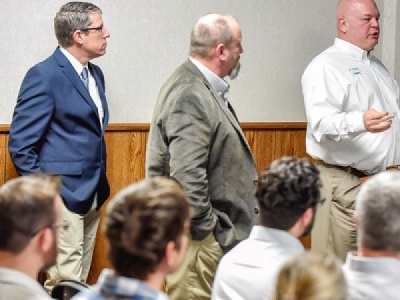
Posted on April 5, 2018
By Mark Andersen, The Daily Republic
Coring samples taken from Lake Mitchell in February revealed the volume of sediment laden with algae-producing phosphorus may be up to eight times what was earlier estimated, throwing a $7.2 million estimate for a lake cleanup project into question.
Mitchell City Council members said they were unwilling to proceed on a plan to spend $385,000 toward the $7.2 million phase one of the lake cleanup, especially given the added uncertainties.
Ultimately, the council voted 7-1 to fund an additional $80,000 to refine the project costs over the coming eight weeks, with Councilman Kevin McCardle casting the sole nay vote.
Mike Sotak of the city’s lake consultant, Omaha-based Fyra Engineering, said he could not produce a better estimate of costs without working through the results of February’s core samples.
“I don’t know what this means with the $7.2 million project,” Sotak told the Council. “All of this sediment presents a challenge.”
The early estimates said about 250,000 cubic yards of the lake would need to be dredged, but preliminary information from the February study show the total is closer to 2 million cubic yards.
Not all of the sediment may need to be dredged, Sotak emphasized. The depth of the material containing phosphorus varies widely around the lake, and deep areas could be capped with clay and neutralizing alum to reduce algae blooms. Over the next eight weeks, Fyra will examine cost options for dredging and capping.
The vote to provide the money came after a wide-ranging two-hour presentation before a packed meeting room at city hall.
An issue repeatedly raised by members of the Lake Advisory Committee was that a comprehensive and multifaceted plan was needed to address problems at the lake. Proposals being offered in the community as cheaper and simpler solutions will have no better result than failed efforts tried in the past, said Dr. Paula Mazzer, Dakota Wesleyan University professor and a member of the lake Technical Advisory Team Committee.
Of the solutions offered by those companies, Mazzer said, “Each is trying to sell us something.”
Greg Kipp, of Rapid City-based Verax environmental consulting, said past alum treatments at the lake failed at least partly because phosphorus bound to iron in the lake is released into the water after dissolved phosphorus is removed from the lake.
Council members reacted with a lot of questions to the new information.
Council member Marty Barington wondered where up to 2 million cubic yards of lake sediment could be dumped.
He wondered whether it wouldn’t be better to begin work limiting phosphorus coming into the lake from Firesteel Creek.
Sotak said lake improvements would not be noticeable in this lifetime without dealing with the phosphorus currently stored in the lake sediment.
Council member Mel Olson proposed spending the additional $80,000 to get a better cost estimate.
“To get some answers, we’ve got to spend some dough,” he told the rest of the council. Calling a halt to the project after so much time had been invested by community members to find a solution would not be acceptable.
The problems at Lake Mitchell are not just a problem for people living around the lake, he said.
“If we don’t have the lake, our community loses everything,” Olson said. It’s an economic development issue, he said. The $80,000, he said, would put good numbers behind the project costs so the council can make a better decision.
Earlier, Sotak apologized “for the headaches” caused when his business did not acquire a South Dakota engineering license earlier during the process of trying to solve Lake Mitchell’s algae woes.
Source: The Daily Republic





